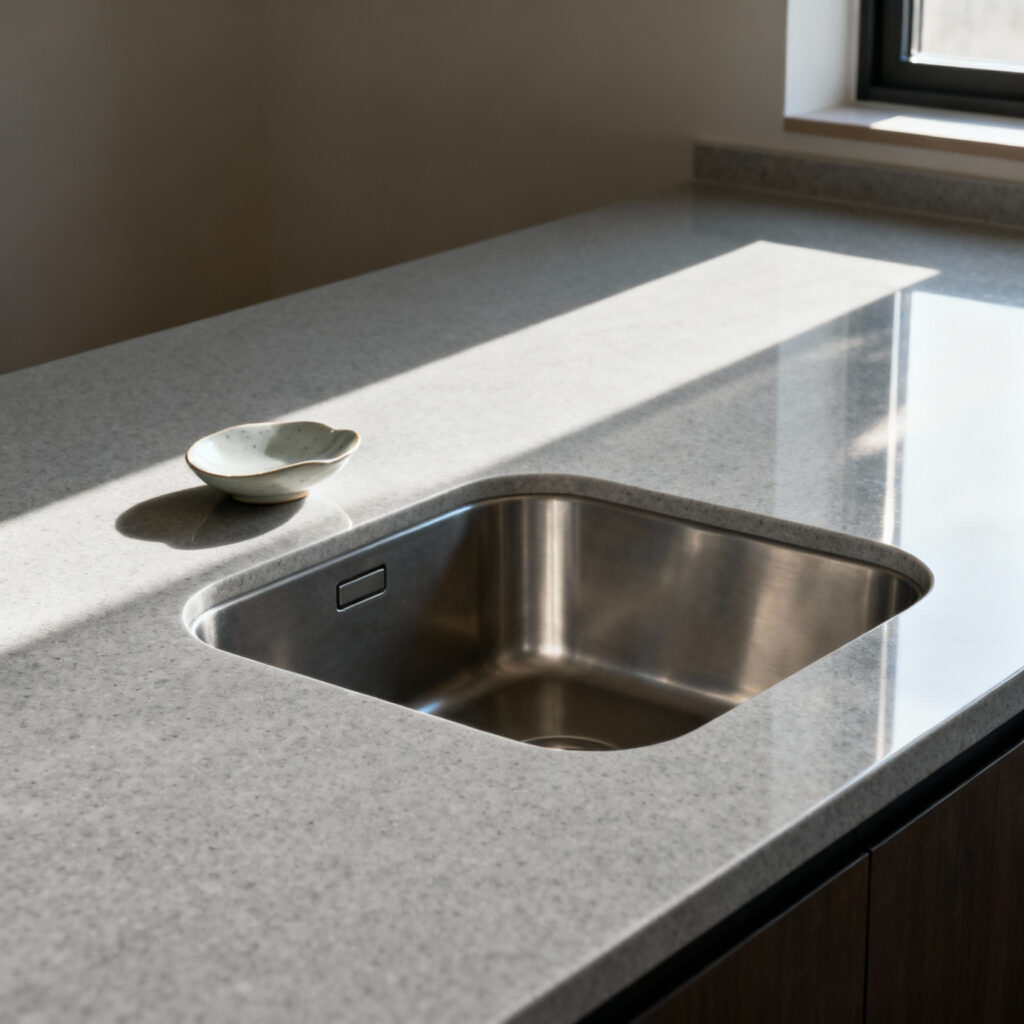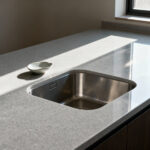Since the Kamakura period, principles such as Ma—the elegant power of emptiness—and Wabi-Sabi—the profound beauty of imperfection—have served as more than aesthetic guidelines; they are fundamental approaches to living. Evolving from monastic practices and refined domestic rituals to contemporary frameworks for serene living, this wisdom remains potent. Today’s most considered spaces understand a dual mandate: true utility is elevated when imbued with beauty and intention. The twenty principles that separate mastery of kitchen sink organization from mere decluttering haven’t changed in centuries. They reflect a timeless quest for harmony.
The kitchen sink is the heart of daily activity and, often, a vortex of disarray. Yet, seen through this lens, this utilitarian hub transforms into a canvas for mindful design. It becomes a microcosm where the interplay of elements, the reverence for materials, and the efficiency of space planning can influence the atmosphere of the entire home. Thoughtful kitchen sink organization becomes a practice, a daily ritual to cultivate a sense of serene flow, impacting not just our work but our state of being.
This exploration will guide you through twenty interwoven principles, unfolding from the abstract depths of philosophy to their concrete application. We begin with ‘Cultivating Philosophical Depth’ to anchor your sink’s serenity, then move into ‘Curating Enduring Aesthetics’ through materials. We will proceed to ‘Orchestrating Precision’ with spatial applications, and finally, integrate ‘Rhythmic Rituals and Sustained Harmony’ into daily living. Each principle, rooted in enduring aesthetic wisdom, offers a pathway to transform a commonplace area into an oasis of purposeful beauty. Prepare to discover a profound elegance in the everyday.
Cultivating Philosophical Depth: Anchoring Your Sink’s Serenity (Part 1)
Our journey begins not with physical rearrangement, but with a shift in perception. This is about anchoring your most functional space in a restorative calm, allowing ancient wisdom to guide your modern domestic harmony.
1. Cultivating Ma: Embracing Intentional Negative Space Around Your Basin
In Japanese design, we understand that what is not there is as important as what is. This is Ma—not mere emptiness, but a vibrant, intentional void that gives meaning to the elements within it. When we apply this to the kitchen sink, we must resist the impulse to fill every surface. The countertops flanking your sink are not storage; they are canvases where Ma can be cultivated. By leaving these areas uncluttered, you create a visual and energetic spaciousness that allows your sink to breathe.
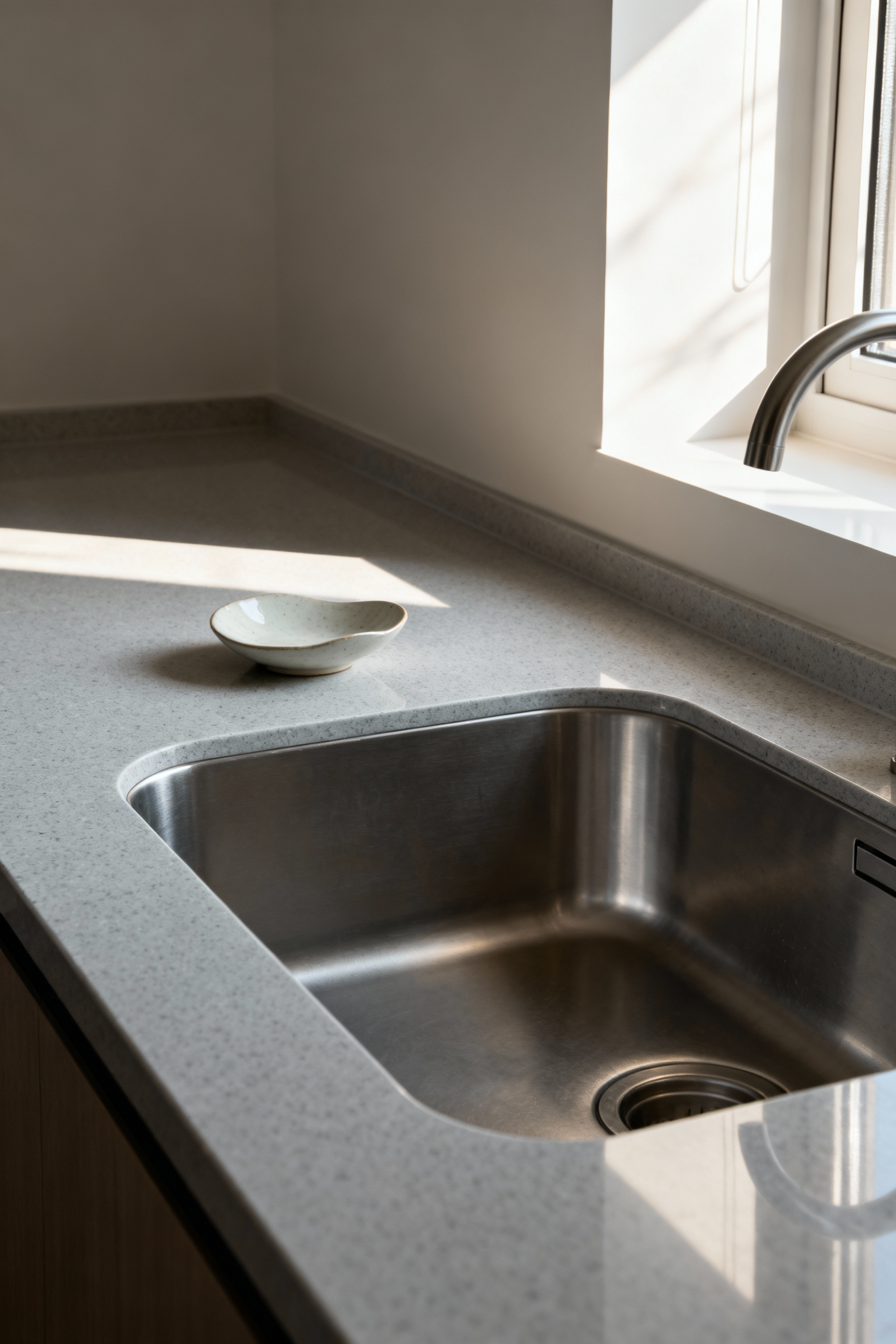
Imagine your basin not as a receptacle for overflow, but as a solitary element deserving of its own contemplative periphery. A single, beautifully crafted hand soap dispenser becomes an anchor, allowing the quiet of the countertop to speak. This restraint reduces visual noise and fosters mental clarity. From my work in Japanese aesthetics, I’ve learned that this discipline is not about having less, but about making what you have matter more. The simple act of washing dishes becomes a mindful engagement when your workspace embodies a serene, uncluttered presence.
2. Harmonizing Imperfection: Discovering Wabi-Sabi in Natural Sink Materials
From the quiet of Ma, we flow into Wabi-Sabi, the philosophy that finds an exquisite beauty in imperfection and transience. While a pristine, unblemished sink is a common ideal, Wabi-Sabi encourages us to find dignity in the subtle marks of use that emerge over time on natural materials like fireclay or copper. A gently worn wooden board resting nearby, its surface etched with the history of meals, tells a more compelling story than a perfect, untouched one.
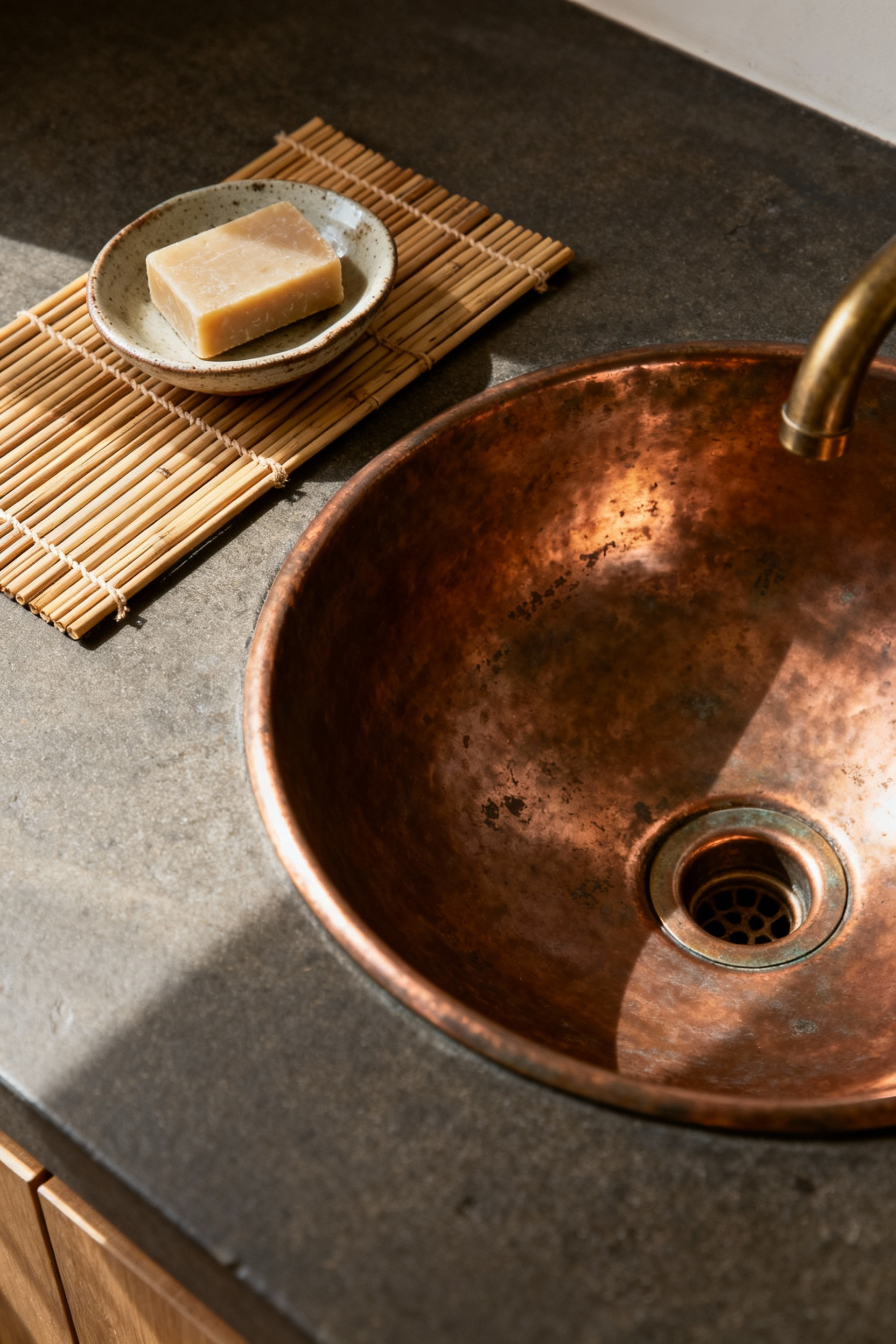
Consider a simple earthenware soap dish or a natural stone sponge holder. As these items interact with water and daily use, they will change. A water stain, a deepening hue—these are not flaws to be hidden. They are testaments to life being lived. This is the very soul of an object revealing itself, connecting us to the passage of time. The key is choosing materials that age gracefully. By embracing Wabi-Sabi, you invite an authentic aesthetic into your home, transforming the mundane into a meditative appreciation for the imperfect, yet profound, narrative of daily life.
3. The Ikigai of Utensil Placement: Finding Purpose in Every Item’s Dwelling
We transition from appreciating materials to the conscious arrangement of our tools. This brings us to Ikigai, the Japanese concept of ‘a reason for being.’ Applied to kitchen sink organization, Ikigai demands we understand the precise ‘why’ behind an item’s placement. Every utensil, every brush, every bottle must possess its own Ikigai within the sink’s ecosystem. A scrub brush beside the faucet has a clear purpose: immediate use. It belongs there.
This principle demands a quiet but firm self-inquiry. If an item lacks a clear purpose in its designated spot, its presence disrupts the harmony. It has no Ikigai. The process of organizing then becomes a meditative exercise in defining function. We are not just storing; we are assigning a purposeful dwelling. Group items by frequency of use. By ensuring every item fulfills its purpose through conscious placement, your sink area transforms from a collection of objects into a purposeful, serene domain that supports your work with effortless grace.
4. Miyamoto Musashi’s Two-Sword Principle: Efficiently Decluttering Countertops for Clarity
From the existential resonance of Ikigai, we turn to a more martial, yet equally profound, philosophy for efficiency: Miyamoto Musashi’s ‘Two-Sword Principle.’ Musashi advocated mastering both a long and short sword simultaneously to achieve a fluid, adaptable, and efficient balance. For us, our tools are our ‘two swords’—we maintain only what is necessary and supremely effective. The countertops flanking your sink are your dojo, and the goal is an unburdened, decisive workspace.
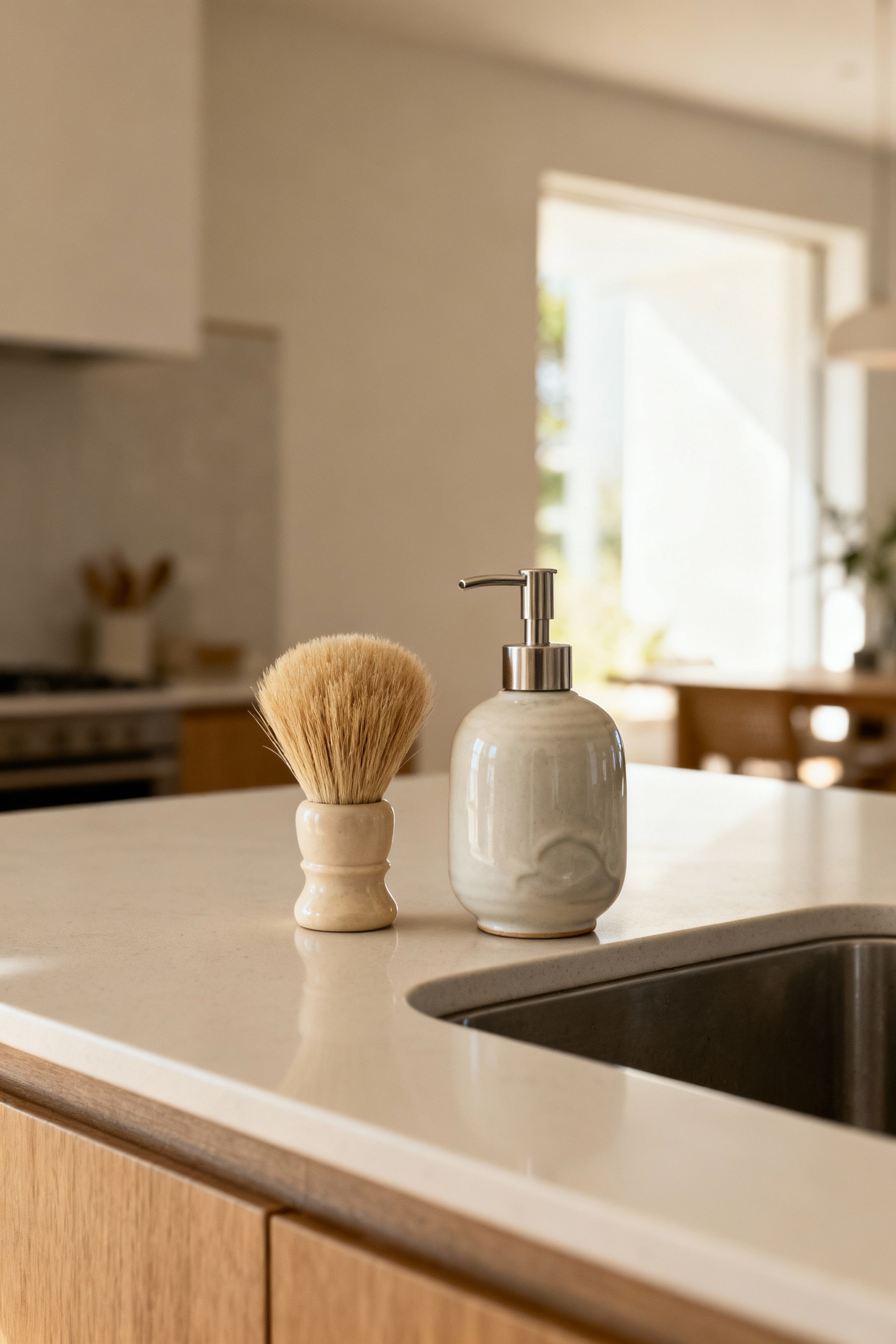
Instead of a myriad of specialty cleaners and redundant sponges, apply Musashi’s wisdom. What are the two or three most effective, versatile tools for your daily tasks? Perhaps a single, high-quality dish soap and a multi-purpose cleaner. One well-chosen scrubber. This principle compels us to remove anything that acts as visual or functional impedance. If an item is not frequently called to action, it must be removed from the immediate countertop arena. This strategy isn’t about harsh minimalism, but about fostering an environment of effortless capability and visual clarity.
Cultivating Philosophical Depth: Anchoring Your Sink’s Serenity (Part 2)
Building upon clarity and intention, we delve deeper into the sensory and spiritual dimensions of our interaction with the kitchen sink. We explore how nature can transform a utilitarian space into a sanctuary, anchoring our daily rituals in profound quietude.
5. Shinrin-Yoku at the Sink: Infusing Natural Elements for Sensory Serenity
Shinrin-Yoku, or “forest bathing,” is an immersion into the natural world to awaken the senses. Transposing this to the kitchen sink offers a profound opportunity to infuse sensory engagement into daily routine. The simple act of washing and preparing becomes mindful when imbued with nature’s reverence. To manifest Shinrin-Yoku, your material choices are paramount. Opting for natural, unprocessed materials grounds the space. Consider the warmth of bamboo or teak for a dish drying rack, its grain inviting gentle interaction. A handcrafted ceramic soap dispenser introduces the subtle imperfections of Wabi-Sabi.
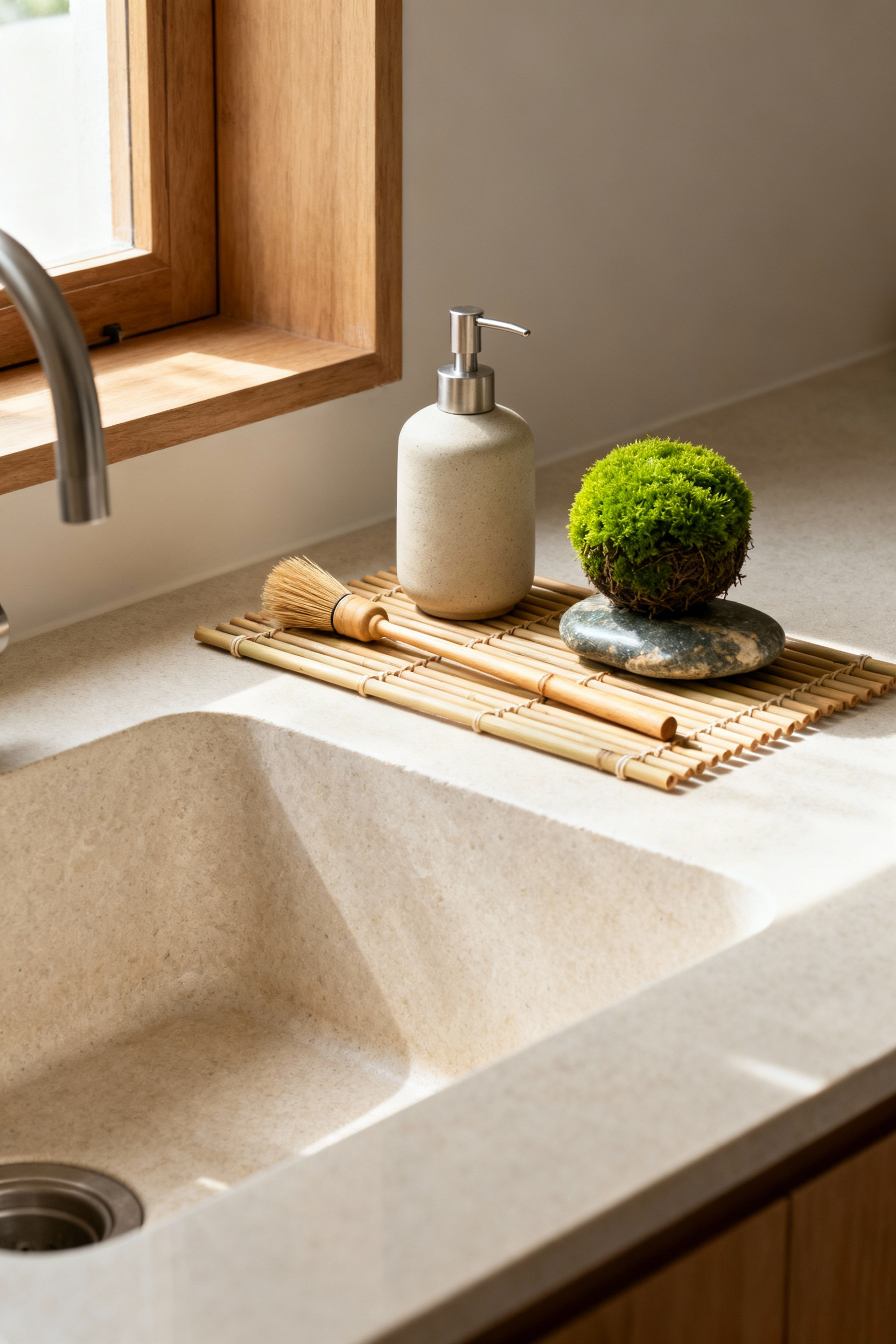
River stones, thoughtfully arranged, bring elemental grounding. Linen dishcloths replace synthetic uniformity with nuanced authenticity. These choices form an intentional bridge to the natural world. Spatially, a small herb plant—perhaps mint or basil—positioned by a window introduces living vitality. Years of traditional Japanese architecture background taught me the importance of how light interacts with a space; optimize natural light, allowing it to dance on water and illuminate textures, evoking dappled forest light. Integrating these principles transforms a chore into a micro-retreat. The feel of bamboo, the scent of fresh herbs, the sight of light on stone—these details foster mindfulness, reducing stress and elevating routine tasks into cherished rituals.
Curating Enduring Aesthetics: The Art of Material Exploration for Sink Ecosystems (Part 1)
The materials we choose for our sink ecosystem are profound declarations of our aesthetic philosophy. This section delves into the thoughtful exploration of enduring materials, guiding us toward a poetry where every element contributes to a harmonious narrative of intentional living.
6. Utsuwa Philosophy: Selecting Functional Vessels with Timeless Grace
The concept of Utsuwa, referring to vessels, expands beyond utility to encompass an object’s role in elevating an experience. Applied to kitchen sink organization, this philosophy invites us to see the soap dispenser or brush holder not as mundane accessories but as vital participants in our daily rituals. To select these vessels with ‘timeless grace’ is to seek materials that possess inherent beauty and integrity. A weighty ceramic soap dispenser, its surface imperfectly formed by human hands, or a precisely carved hinoki wood tray designed to cradle a brush.
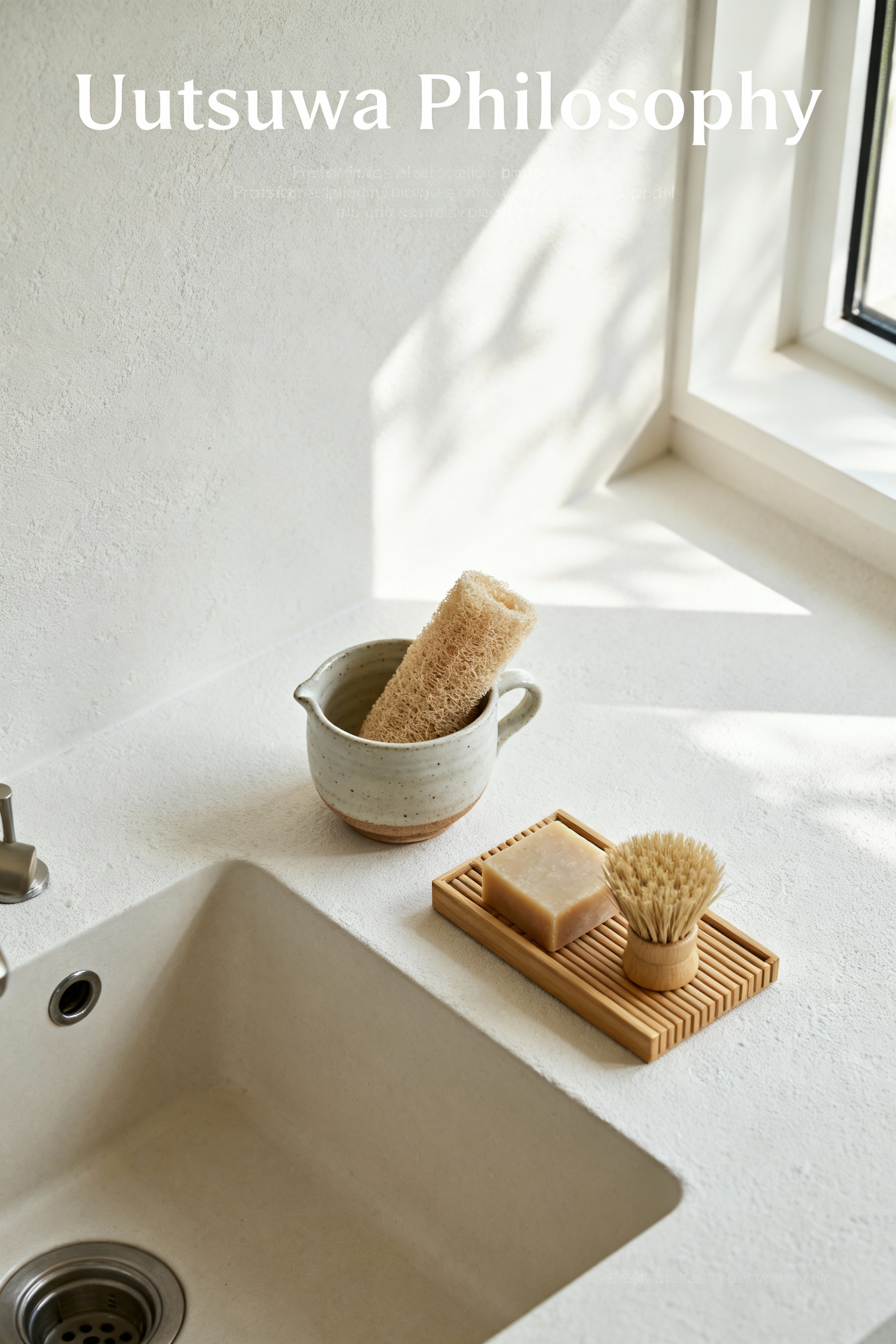
These are not static pieces; they are interactive elements. Their tactile quality, their form, and their eventual patina become part of the ritual. Instead of plastics that degrade, an Utsuwa-inspired selection champions permanence through ceramics in muted earth tones or rich, sustainable woods. The grace in these selections lies in their ability to perform their function flawlessly while enriching the aesthetic landscape. They introduce a contemplative pause into the prosaic act of dishwashing, reminding us that even the most utilitarian aspects of our home can be sources of quiet beauty.
7. Sublime Tactility: Opting for Porous Stone and Ceramic Caddies for Patina
This philosophy extends to the exploration of materiality itself, particularly through a lens that reveres the passage of time. For elements like caddies designed to hold sponges or brushes, the choice of porous stone or unglazed ceramic introduces a depth of character that polished surfaces cannot convey. Here, the pursuit is not of pristine newness, but of a quiet grandeur that evolves with use. Imagine a small caddy sculpted from basalt, its volcanic texture providing a firm grip, or a piece of unpolished travertine, its cool surface offering a comforting weight.
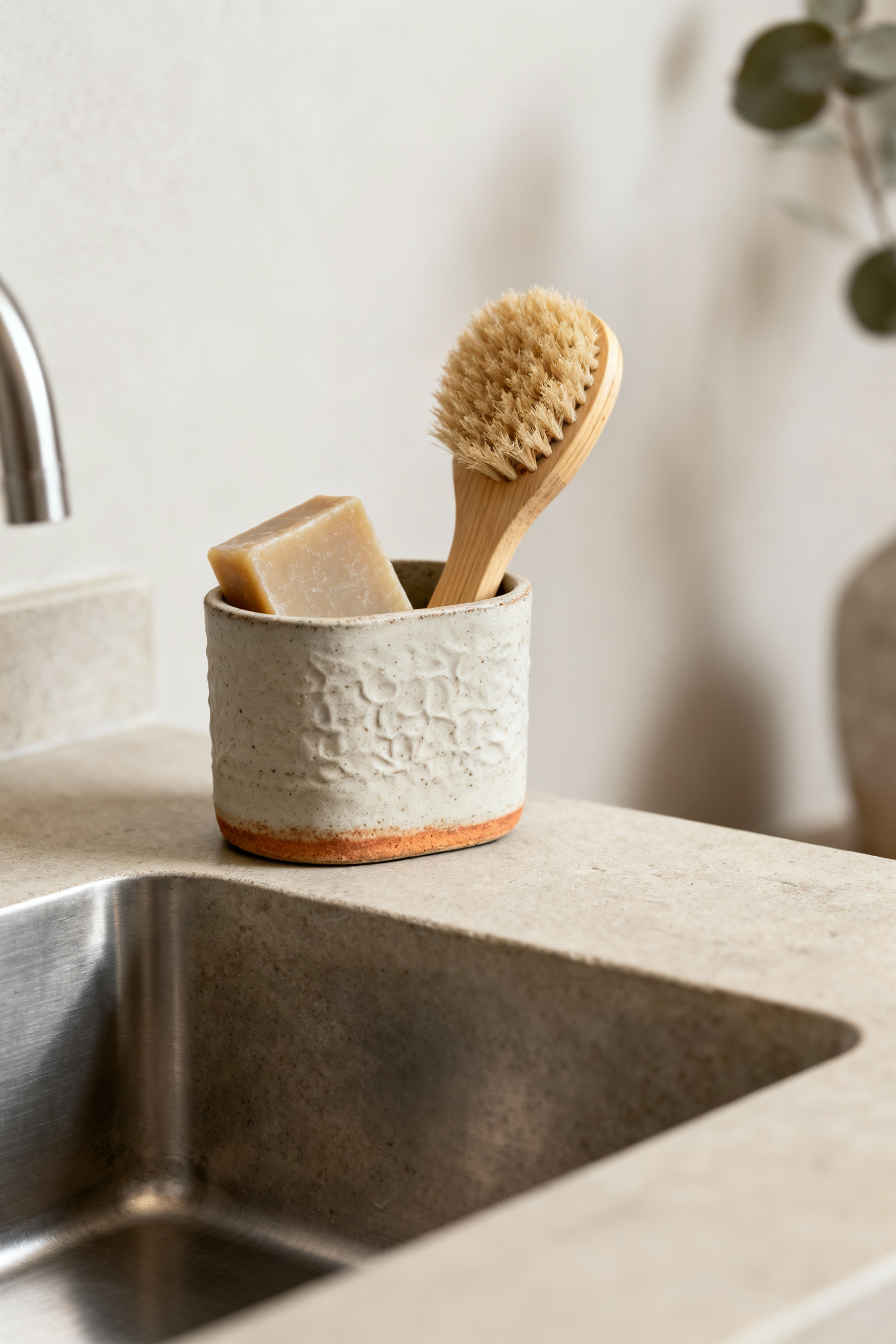
These materials, by their nature, invite interaction and bear the gentle imprints of life. Unlike impervious plastics, porous materials absorb, deepen, and subtly shift in hue, telling a story of daily utility. A ceramic piece will acquire a faint sheen where it is frequently touched. These transformations are not flaws but testaments to the object’s enduring presence—a profound embodiment of Wabi-Sabi. The tactile experience is paramount, offering a grounding sensation, a connection to the earth that transcends mere function.
8. Invisible Fortification: The Merits of Hydrophobic Sealants for Natural Countertop Resilience
This deep appreciation for material integrity extends to the less visible, yet crucial, aspects of organization: the fortification of our natural countertops. True harmony resides in the invisible support that ensures their surroundings remain enduringly beautiful. Here, we delve into the subtle power of hydrophobic sealants—a hidden technique—that preserves the splendor of surfaces like natural stone or unsealed wood. These advanced sealants create an imperceptible barrier, repelling water and oils at a molecular level and preventing stains.
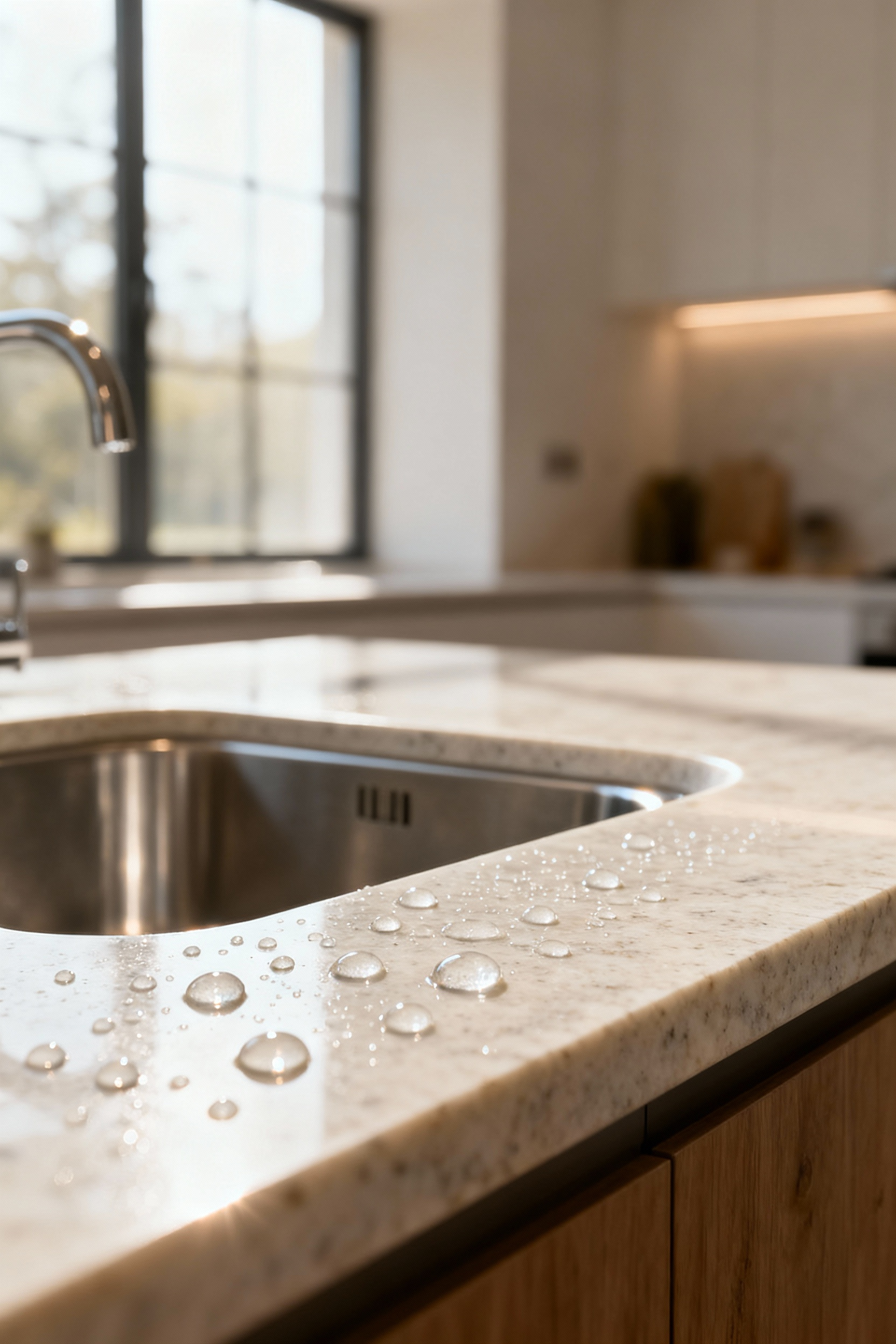
For a cherished marble or soapstone counter, this silent guardian offers invaluable peace of mind, allowing the stone’s inherent beauty to flourish. What really gets me is how this embodies a philosophy of responsible stewardship and quiet mastery. By proactively integrating these measures, we affirm our commitment to the longevity of our materials. It reduces the need for harsh cleaning agents, thereby preserving the material’s character and contributing to a more sustainable, less-effortful approach to maintenance. It ensures that genuine serenity stems from both visible grace and unseen resilience.
9. Akari-Inspired Illumination: Enhancing the Task Area with Deliberate Lighting Fixtures
This thinking applies even to the intangible material of light itself. The quality of illumination profoundly shapes our experience of the sink area. Drawing inspiration from the delicate Akari paper lanterns designed by Isamu Noguchi—works celebrated for their ability to diffuse light with a poetic grace—we are invited to reconsider lighting as a deliberate aesthetic choice. For the task area, thoughtful lighting can create an atmosphere of serene productivity.
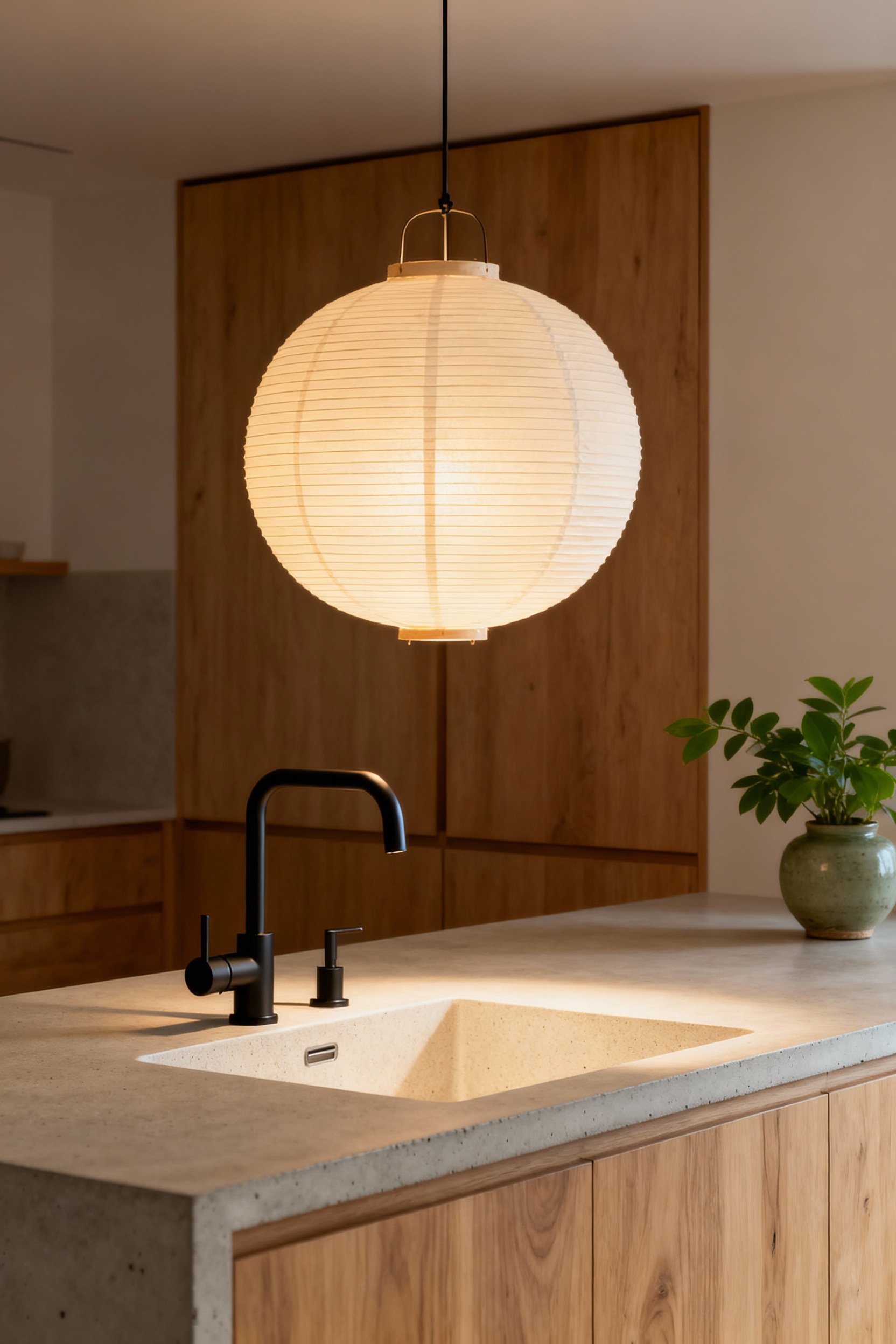
Instead of harsh, direct illumination that casts stark shadows, Akari principles advocate for soft, diffused light. This might be a suspended fixture with a washi paper shade, frosted glass, or woven fabric that scatters the light. The intent is to eliminate glare and cast a gentle glow upon the task at hand. It emphasizes the concept of Ma, the conscious appreciation of the interplay of light and shadow, allowing the eye to rest and the mind to focus. This deliberate lighting transforms the practical into the profoundly pleasant, embodying the understanding that a well-lit space nurtures both our tasks and our inner calm.
Curating Enduring Aesthetics: The Art of Material Exploration for Sink Ecosystems (Part 2)
This segment delves deeper into the selection of materials, moving beyond functionality to embrace their intrinsic qualities. We explore how elemental choices, imbued with a quiet purpose, can elevate the pragmatic realm of kitchen sink organization into a serene landscape.
10. The Breath of Wood: Integrating Sustainable Bamboo or Hinoki Organizers for Moisture Regulation
True mastery in organization lies in discerning the materials we invite into our sanctuary. Japanese aesthetics, particularly the principles of Kanso (simplicity) and Shizen (naturalness), beckon us to acknowledge the innate wisdom of elements like wood. It embodies philosophy, bringing warmth, organic texture, and groundedness to a space often dominated by cooler surfaces.
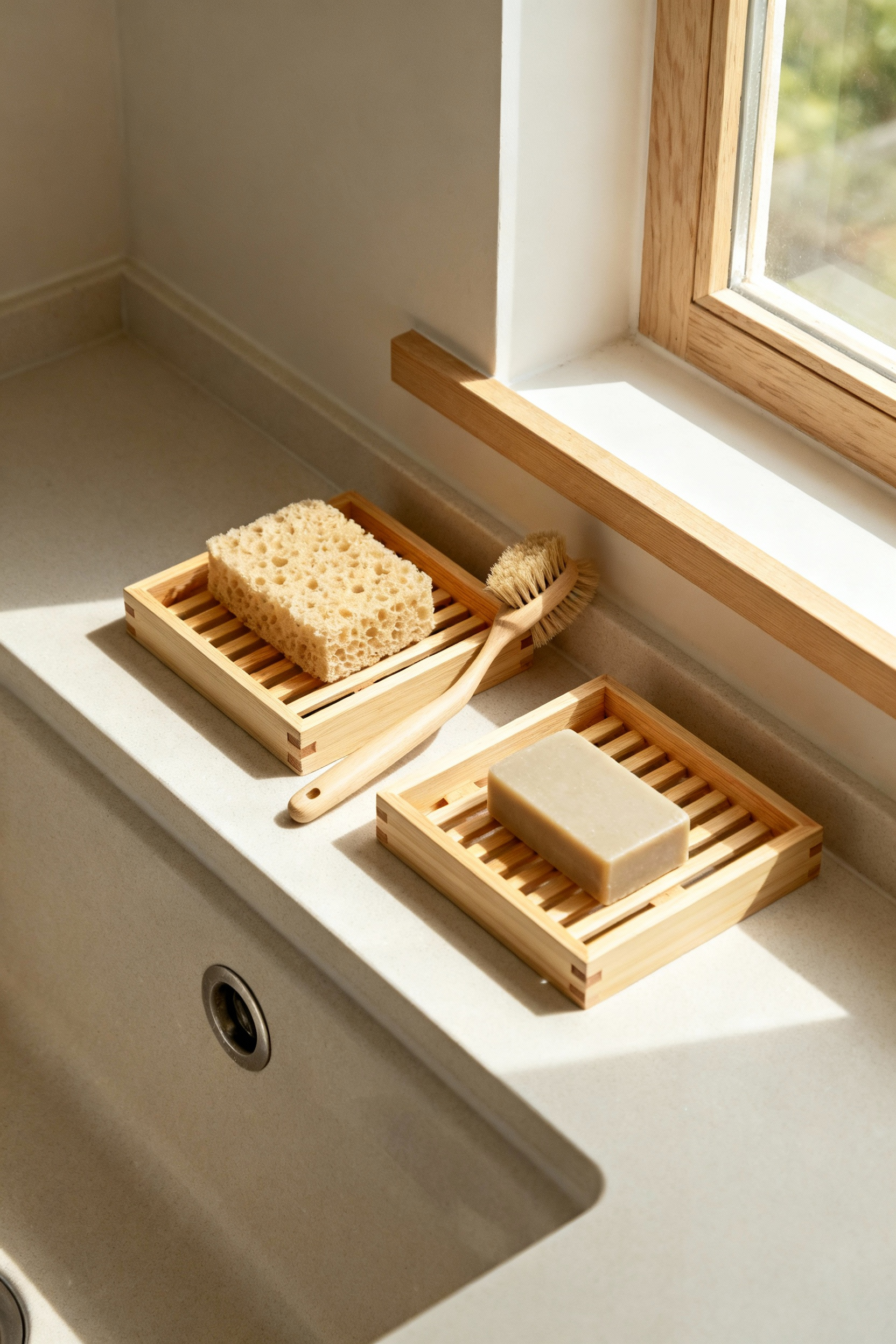
Among nature’s gifts, bamboo and Hinoki wood excel here. Bamboo, a paragon of renewability, has a unique cellular structure granting it natural resistance to moisture and microbial growth. Hinoki cypress, revered in Japan, offers another layer of sophistication. It emits a subtle citrus-pine fragrance and is rich in phytoncides—natural antimicrobial compounds. This makes Hinoki ideal for elevated drying racks or drawer dividers. As these wooden pieces age gracefully, displaying the gentle marks of use, they tell a story, imparting an authenticity that modern, sterile materials lack.
Orchestrating Precision: Strategic Spatial Application Beneath and Around the Sink (Part 1)
The often-overlooked area beneath the sink holds profound potential. This section delves into strategic spatial applications, meticulously transforming zones of potential chaos into havens of order and serene functionality.
11. Monochromatic Minimalism: Standardizing Bottle Hues for Visual Tranquility
Serenity begins with the subtlest of visual cues. The vibrant cacophony of cleaning product bottles can subtly disrupt our inner stillness. Monochromatic minimalism is not merely an aesthetic choice but a practice rooted in Ma. By harmonizing the visual landscape, we reduce cognitive load, allowing the mind to rest in an environment of understated grace.
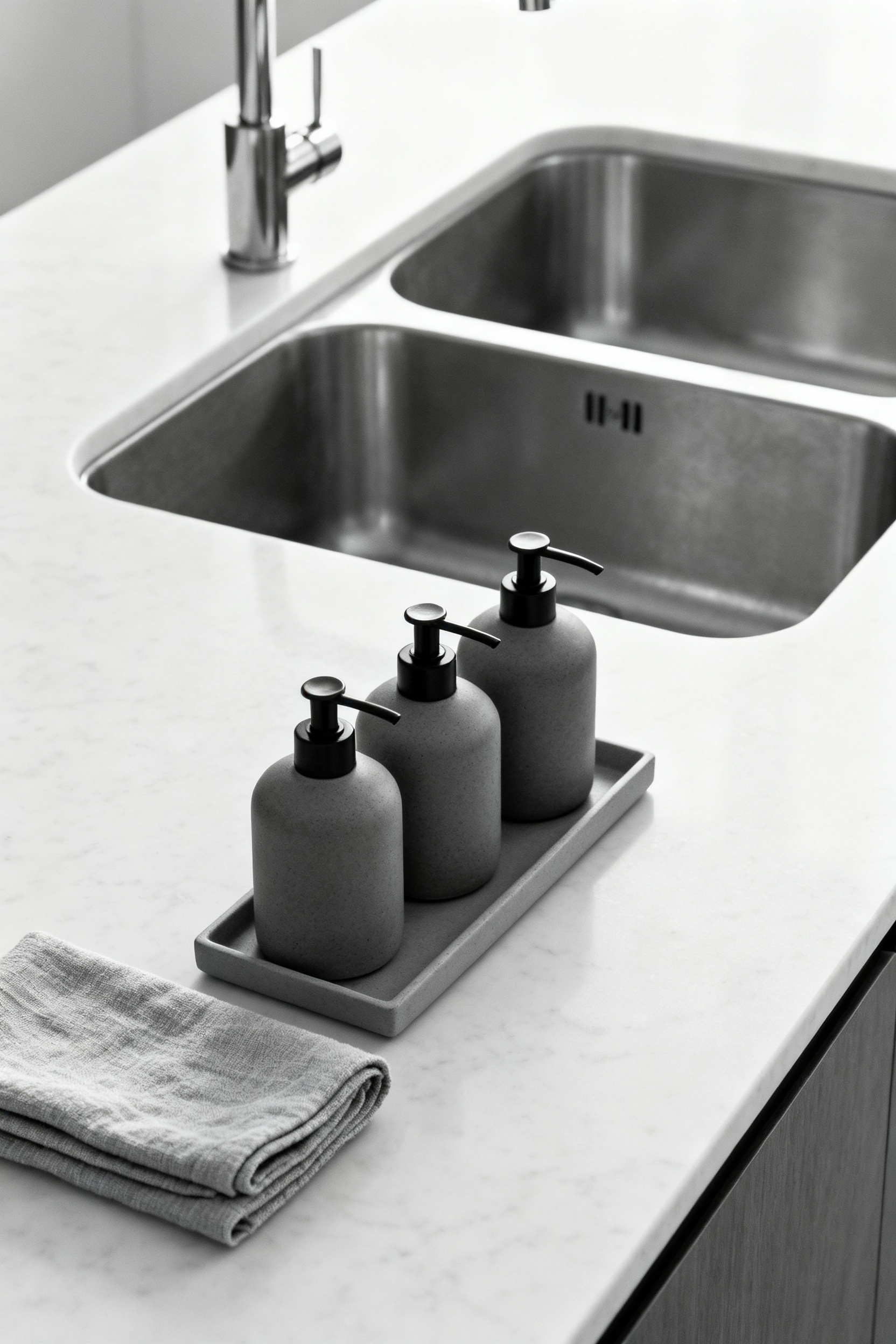
Consider the spectrum of bottles around your sink. Collectively, they can overwhelm. Explore glass dispensers, ceramic bottles, or high-quality vessels unified by a singular color palette—perhaps opaque white, charcoal grey, or a translucent amber. Decant dish soap, hand soap, and cleansers into these matching refillable dispensers. This immediately elevates the aesthetic. This commitment to visual tranquility is a cornerstone of achieving serene flow.
12. Shoji Screen Simplicity: Employing Tiered Dividers and Undersink Drawer Systems for Containment
This philosophy extends to the structural components of organization. The ephemeral elegance of a shoji screen, which gently conceals yet subtly reveals, offers a profound metaphor for effective undersink organization. It teaches us about the beauty of judicious concealment without creating inaccessibility. The goal is an internal landscape of order that is intuitively navigable.
To achieve this simplicity, we explore materials that echo its efficiency: tiered dividers from bamboo or translucent acrylic, or pull-out drawer systems made from powder-coated metal. The cabinet beneath the sink, riddled with plumbing, is a unique challenge. Use tiered, U-shaped shelves to stack items vertically around pipes. For smaller items, undersink drawer systems transform chaotic piles into accessible strata. I’ve noticed in both modern and traditional Japanese homes that what is hidden is often just as considered as what is on display. This hidden order brings a deep sense of peace.
13. Kanso-Inspired Compartmentalization: Mastering the Art of Discrete Categorization for Under-Sink Cabinetry
Building on containment, the principle of Kanso invites us to refine our approach further. Kanso champions simplicity and the elimination of clutter to reveal an underlying order. In kitchen sink organization, it demands we look beyond merely containing items and focus on their purpose and frequency of use. This isn’t about minimalist emptiness, but about functional elegance.
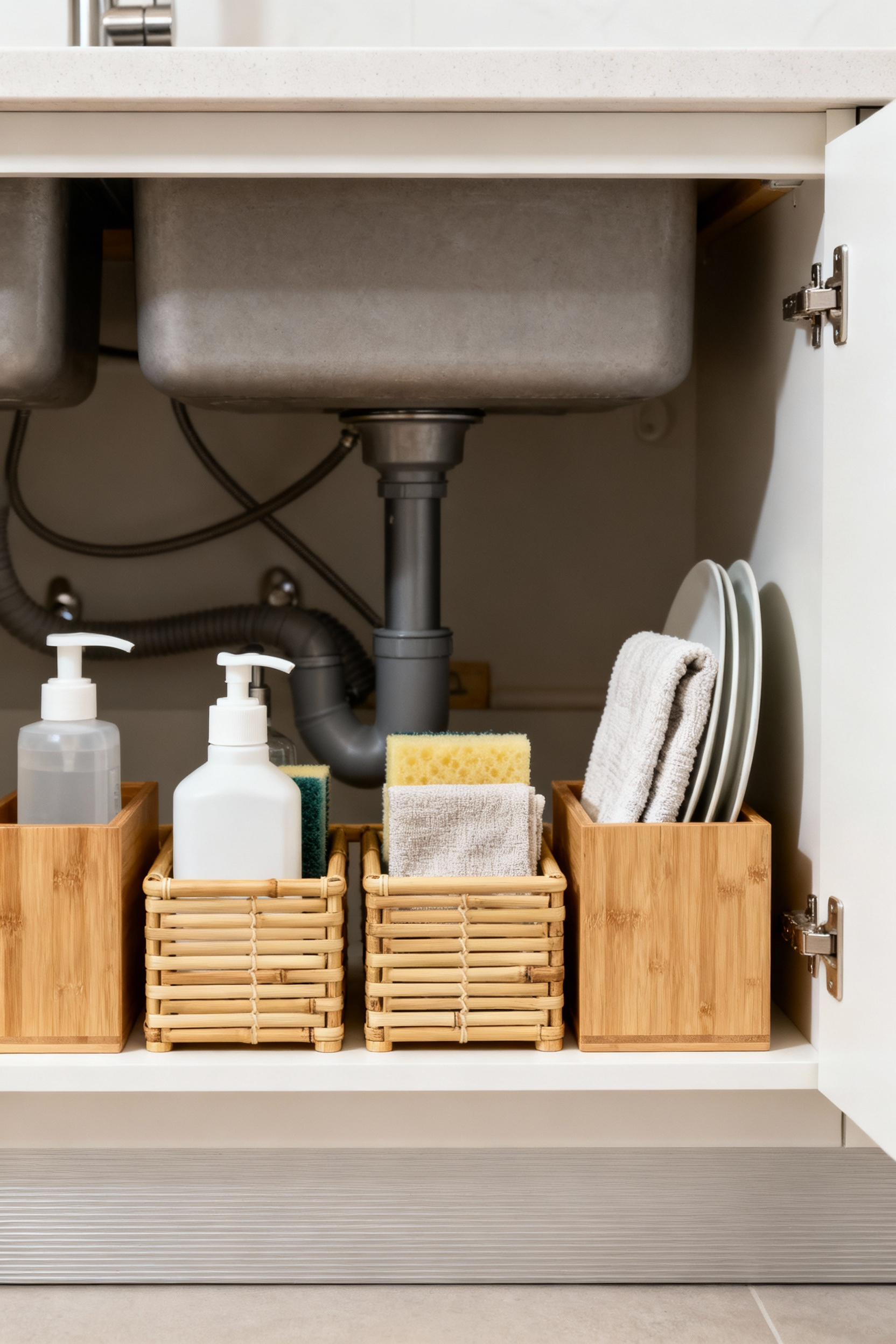
To embody Kanso, choose understated modular containers from clear acrylic or bamboo. The essence of this compartmentalization lies in discrete categorization. Cleaning supplies for surfaces inhabit one bin; dishwashing essentials another; specialty tools a third. This meticulous allocation prevents the creeping entropy that often plagues storage areas. It transforms the under-sink cabinet from a hidden repository into a logical system that supports a mindful daily routine.
14. Kanban for Cleansing Tools: Implementing Visual Management for Sponge and Brush Accessibility
This thinking transforms when applied to our most dynamic tools. Kanban, a visual system for managing work and inventory, offers a potent perspective. It’s about creating a visual signal for what is needed, where it is, and what its status is, fostering a continuous flow. The goal is effortless access and seamless replenishment.
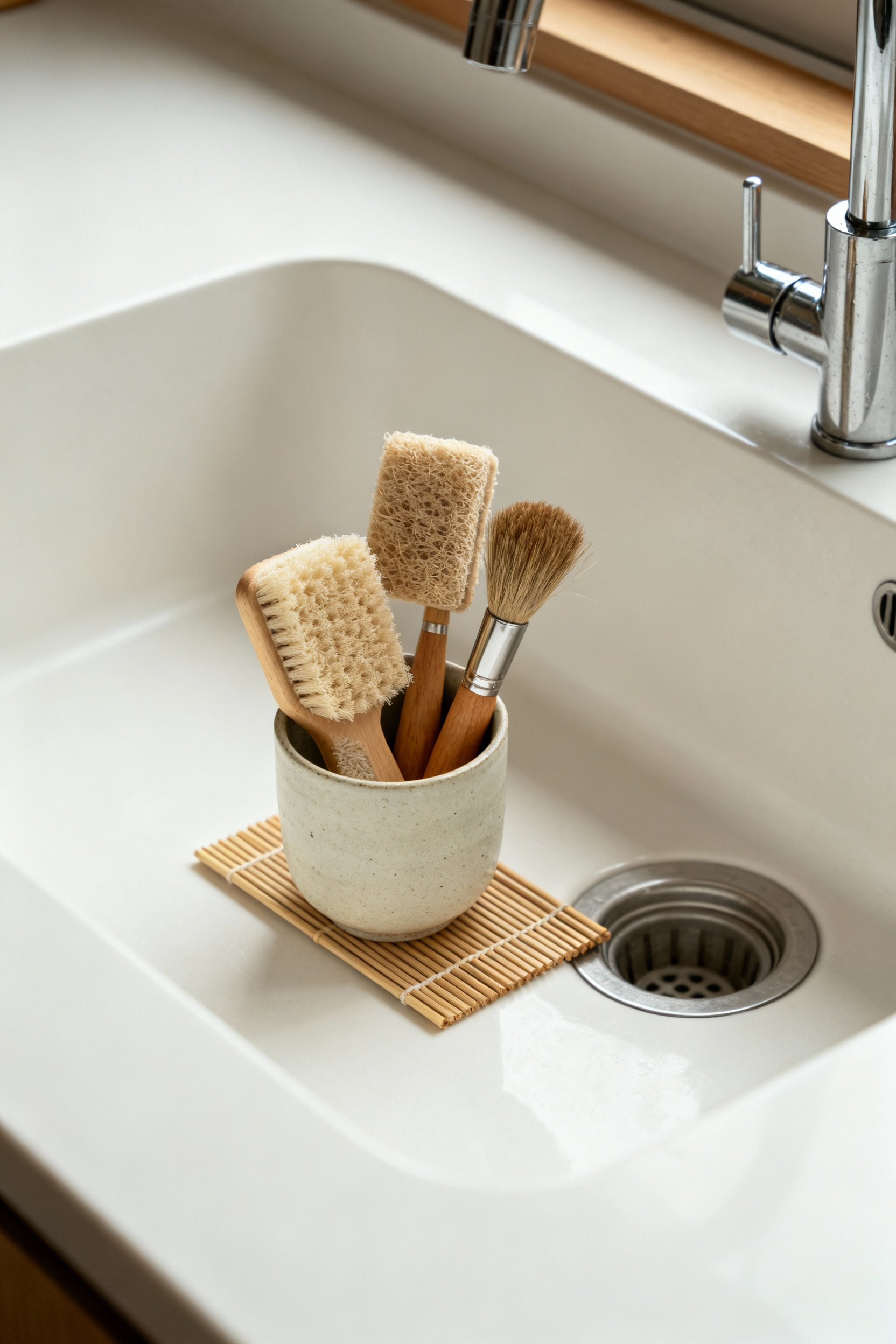
For cleansing tools, the chosen materials must also promote hygiene. Elevated drainage trays from ceramic or bamboo are perfect for sponges and brushes, allowing them to dry thoroughly. The Kanban principle dictates that items should be where they are needed, when they are needed. This means an immediately accessible position around the sink. It’s about presenting functional tools in a way that is both visually orderly and intuitively practical. This active embrace of order is seamlessly woven into the rhythm of daily life.
Orchestrating Precision: Strategic Spatial Application Beneath and Around the Sink (Part 2)
Building upon ‘Ma’ and ‘Wabi-Sabi’, this segment delves into the judicious deployment of tools and techniques. Our focus is orchestrating space with an elegant discretion, ensuring utility never compromises the visual calm crucial to a serene environment.
15. The Art of the ‘Invisible’ Drying Rack: Optimizing Airflow and Discretion with Roll-Up Mats
The pursuit of Ma influences how we approach utilitarian aspects of the kitchen. A fixed, bulky drying rack can become an overt declaration of a chore, eroding the contemplative calm we seek. The essence is finding solutions that recede when not in service, allowing the space to revert to its undisturbed state.
Consider the evolution from rigid racks to the ingenious roll-up drying mat, often crafted from slender silicone-coated steel rods. It unfurls effortlessly across the sink or counter, allowing water to drain directly and promoting optimal airflow. The true marvel is its impermanence; once dishes are dry, it can be rolled up and stored, vanishing from sight and returning the visual plane to a state of pristine clarity. This simple shift empowers you to maintain an aesthetic of serene readiness, fostering a deeper appreciation for the ebb and flow of domestic life.
Rhythmic Rituals and Sustained Harmony: Integrating Organizational Practice into Daily Living (Part 1)
Harmony is not an aspiration but a cultivated state, achieved through mindful practice. This section delves into the daily rituals that transform organization into a contemplative journey, fostering sustained tranquility through consistent engagement.
16. Ichigo-Ichie Principle: Embracing the Moment for Daily Wiping and Spot Cleaning Rituals
Ichigo-Ichie, from the Japanese tea ceremony, reminds us that every moment is unique and will never recur. Applied to the sink, this philosophy elevates the simple act of daily wiping from a chore into a revered ritual. Rather than deferring tidiness, we engage with the present moment. This immediate engagement prevents the incremental accumulation of grime, ensuring the sink never becomes a source of discord.
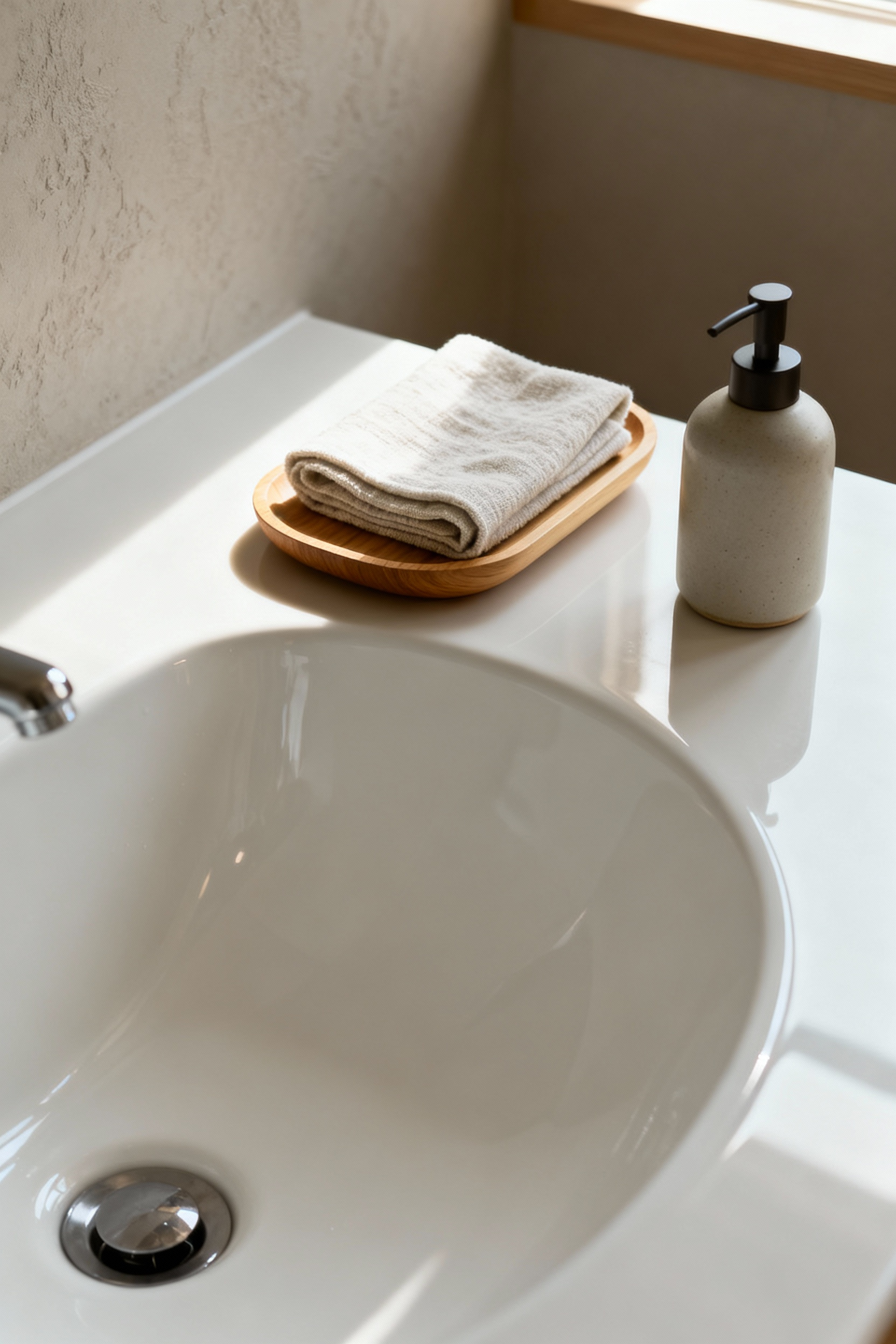
Our approach becomes an intimate dialogue with the material. As we guide the cloth, we observe the play of light on surfaces. This is not frantic scrubbing, but a soft, deliberate presence. I learned this when studying the meticulous care of temple gardens—every small, mindful act contributes to the whole. The tools become an extension of this mindfulness: a soft cloth, a natural bristle brush, and a plant-based cleaner. Integrating this into daily living transforms a mundane task into a personal ritual of respect.
17. Kaizen Micro-Adjustments: Continuously Refinishing Edges and Adapting to Evolving Needs
Following the awareness of Ichigo-Ichie, the principle of Kaizen, or continuous improvement, guides our long-term engagement. Perfection is not a destination but an ongoing journey of small, incremental adjustments. It fosters an adaptive, responsive relationship with our environment.
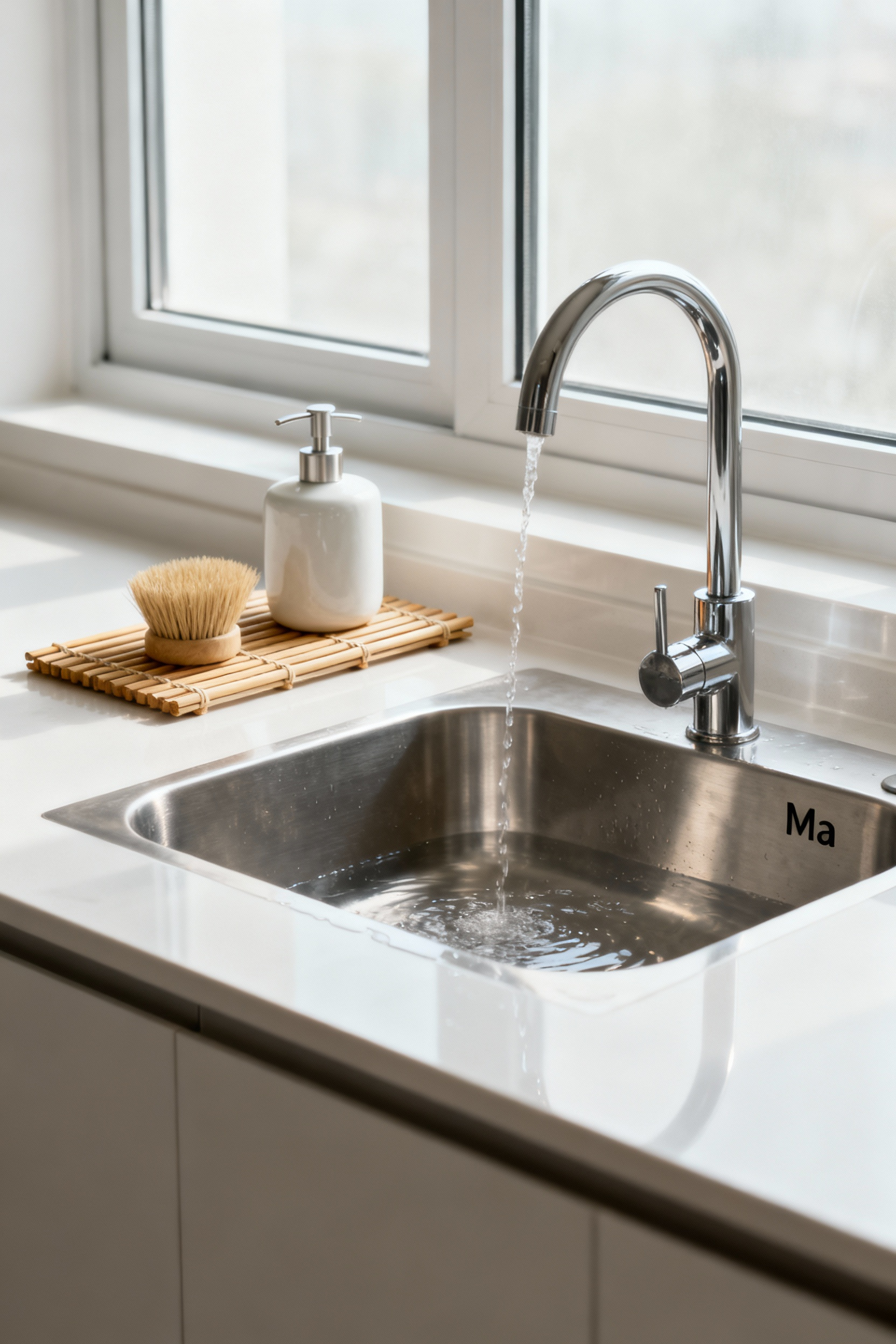
Consider the minor friction points: a dripping caddy, an awkward soap dispenser. A Kaizen lens encourages us to observe these as opportunities for enhancement. This might mean rotating a soap dish or switching to a dispenser with a more ergonomic pump. It’s about ‘refinishing the edges’—smoothing out the small operational snags that impede harmonious flow. By consistently asking, “How can this be slightly better?” we cultivate a resilient and perpetually optimized space.
18. Dan-Sha-Ri: The Art of Mindful Discarding and Resisting Accumulation Creep
Building on daily awareness and continuous refinement, Dan-Sha-Ri offers a powerful framework for preventing clutter. Translating to “refuse, dispose, separate,” it is a profound practice of mindful discarding and resisting “accumulation creep.” It challenges us to evaluate an item’s true resonance with our current life.
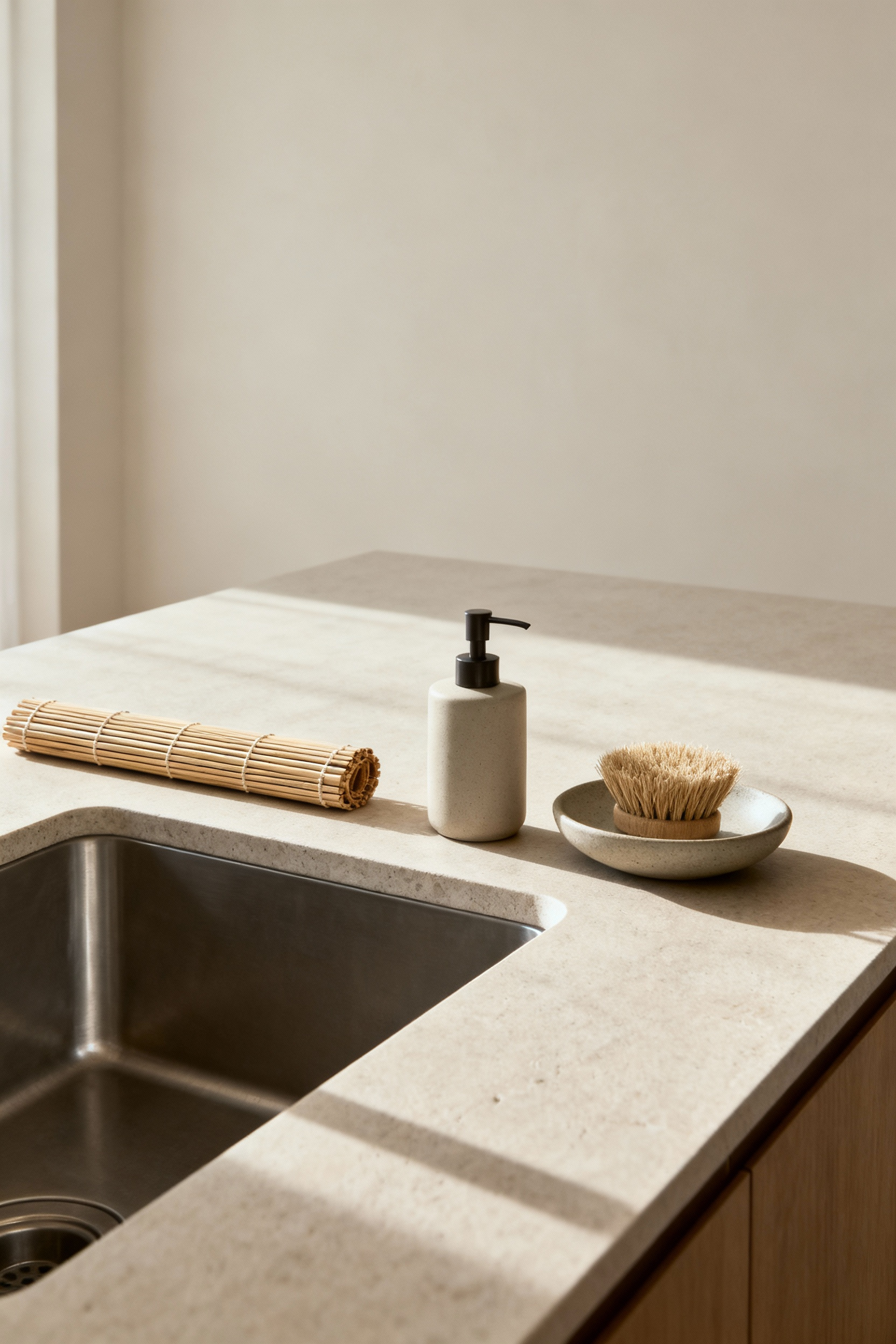
Dan-Sha-Ri compels us to observe the artifacts around the sink. A worn sponge, a cracked ceramic dish, a rusty scourer—we are asked to identify these items and consciously release them, acknowledging their past service. Spatially, this practice liberates the critical Ma. Every extraneous item diminishes this vital space. By removing them, we invite air, light, and mental clarity, allowing the essential items to truly stand out.
19. The Furoshiki of Essentials: Employing Multi-Purpose Cloths and Biodegradable Solutions for Minimal Impact
This final ritual draws inspiration from the Furoshiki—the traditional wrapping cloth, revered for its versatility and sustainable spirit. We apply this principle of multi-purpose functionality to our sink essentials. This philosophy champions fewer, better items.
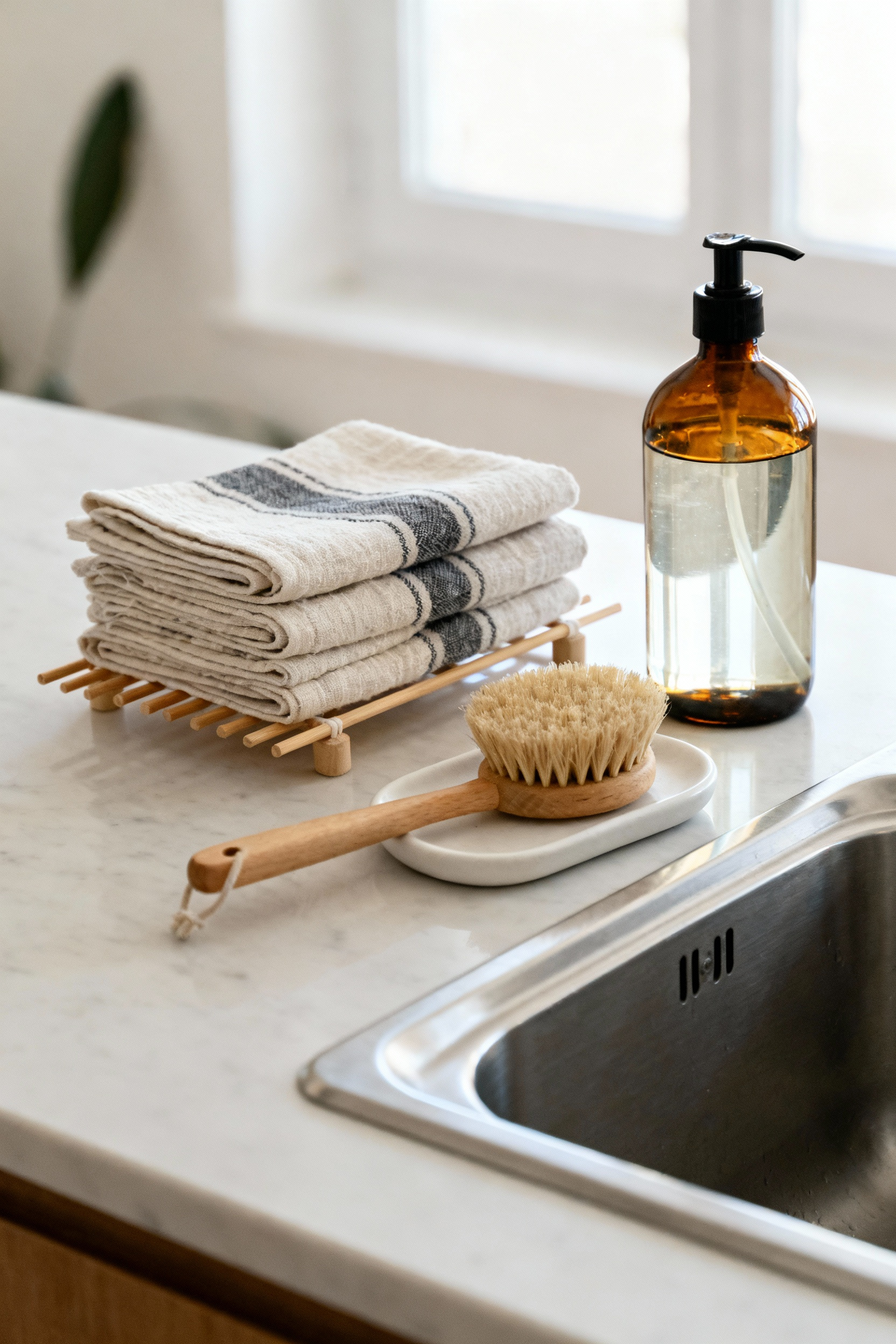
Instead of a myriad of specialized sponges, embrace natural fiber cloths—linen, hemp, organic cotton—which can be washed and reused. Complement these with biodegradable cleaning solutions, like a simple castile soap. This dramatically reduces the parade of plastic bottles. Spatially, this simplifies the entire organization schema. With multi-purpose cloths and versatile cleaning agents, the need for extensive storage vanishes, allowing the purposeful void of Ma to flourish.
Rhythmic Rituals and Sustained Harmony: Integrating Organizational Practice into Daily Living (Part 2)
Following our exploration of design principles, we now focus on maintaining a harmoniously organized kitchen sink. This section delves into integrating rhythmic rituals and diligent practices that embed sustained serenity into the fabric of daily living.
20. Honnō-Ni-Kusuru Maintenance: Automating Replenishment and Schedule Deep Cleans for Enduring Serenity
Honnō-Ni-Kusuru, or “taming instinct,” invites us to craft systems that make order an instinctive response. In kitchen sink organization, this means designing routines for replenishment and cleansing that feel natural and effortless. True serenity is achieved through consistent, mindful engagement—a sustained whisper of diligence rather than a shouted command to chaos.
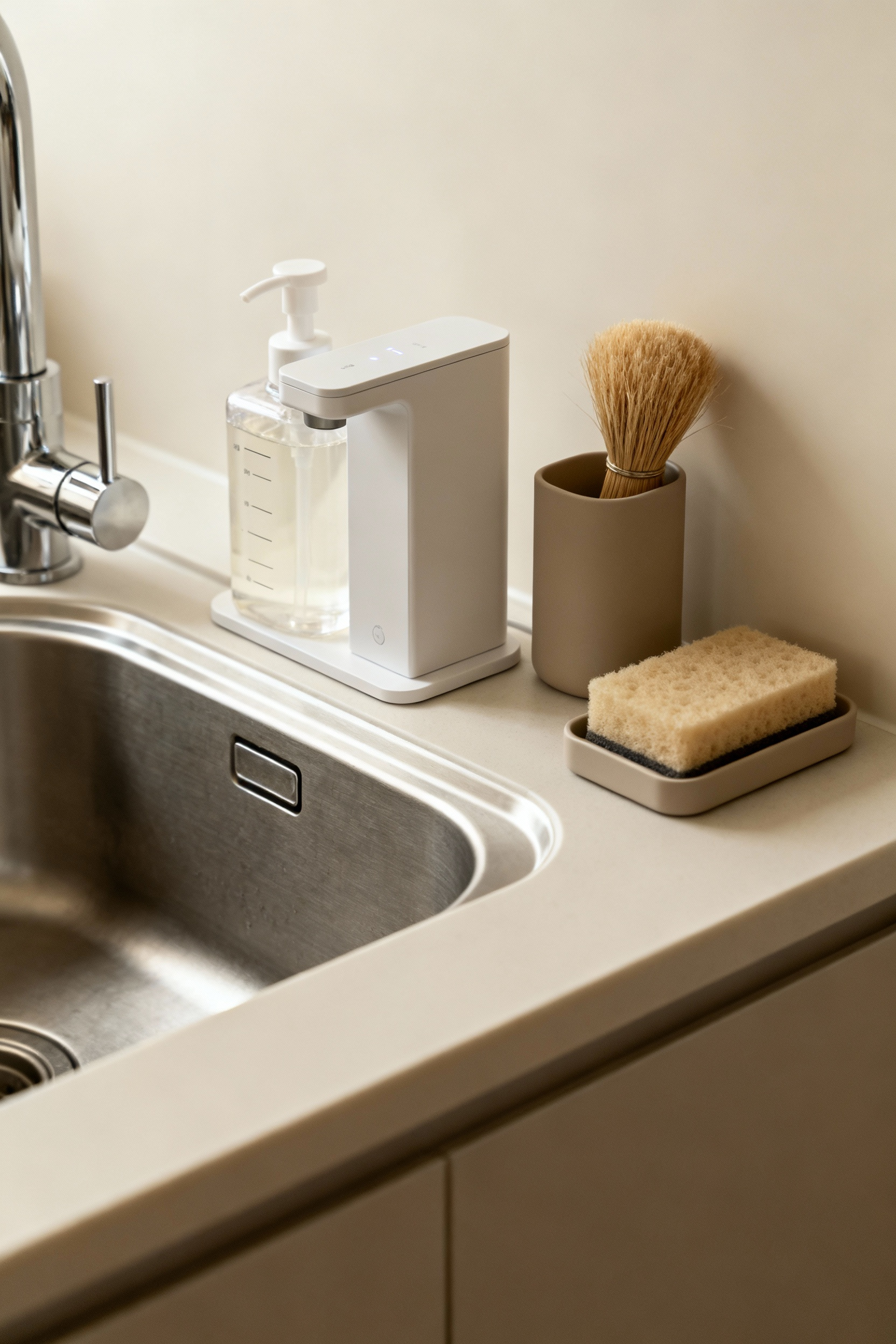
This principle manifests as two interwoven threads: automated replenishment and ritualized deep cleaning. Establish a dedicated, accessible ‘reserve’ under the sink for backup supplies. A mindful check during daily washing prompts refilling before a dispenser becomes empty. Simultaneously, schedule a deeper weekly cleansing ritual—sanitizing the basin, polishing fixtures, organizing the under-sink area. This is not grime removal; it is an act of purification, honoring the space that nourishes and sustains. This practice transforms maintenance into a bedrock of domestic serenity.
Conclusion
Our journey through these twenty principles reveals that mastering kitchen sink organization is an intimate dialogue with the spatial poetry of Japanese aesthetics. We have not simply offered practical strategies but have invited a deeper appreciation for the profound elegance that arises when function harmonizes with intention. The essence of Ma becomes palpable in an uncluttered sink area, while Wabi-Sabi reminds us that beauty resides in the authentic texture of daily use.
I invite you to integrate these timeless tenets not as rigid rules but as guiding inspirations. Elevate your kitchen sink organization from a chore to a meditative practice, imbuing your home with a cultivated serenity. In mastering this micro-environment, we are not merely decluttering a counter; we are curating a philosophy of living where intention precedes action, and tranquility is a tangible presence. Let this renewed approach serve as a small yet potent testament to the profound beauty of mindful living.
